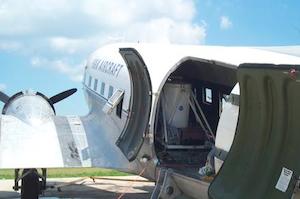

Airborne lidar installed on DC-3 aircraft
Texas Air Quality Study (TexAQS)
Houston, Texas, August - September 2000
The Texas 2000 Air Quality Study is the latest campaign in a series of oxidant/aerosol studies which the National Oceanic and Atmospheric Administration (NOAA), the U.S. Department of Energy, and a number of university scientists have cooperatively conducted under the umbrella of the Southern Oxidants Study (SOS) in affiliation with the North Atlantic Research Strategy for Tropospheric Ozone (NARSTO). Researchers from these organizations are joined by the Texas Natural Resource Conservation Commission (TNRCC) and local communities in undertaking the largest air quality study ever done in the State of Texas.
The Atmospheric Remote Sensing research group contributed to this study by deploying ground-based and airborne lidars, and a surface flux station. These instruments are being used to study the meteorological conditions responsible for the local and regional transport of pollutants and will provide critical information about the spatial distribution and time evolution of ozone and aerosol concentrations. Participating lidar instruments were the TEA CO2 Doppler Lidar, the Ozone Profiling Atmospheric Lidar (OPAL), and the Airborne Excimer Ozone DIAL (ABDIAL).
